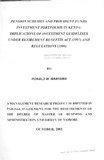| dc.description.abstract | With the level of attention being paid to the provision of adequate retirement benefits for
workers around the world increasing, the idea of reforming the retirement benefits sector to
deliver intended services to beneficiaries effectively has become a central issue. To be in
tandem with global developments, the government of Kenya enacted the Retirement Benefits
Act (1997) and the Retirement Benefits Regulations (2000). The main thrust of the Act was the
establishment of the Retirement Benefits Authority for the regulation, supervision and
promotion of retirement benefits sector and for connected purposes. These were the main
missing links in the administration of retirement benefits schemes in the country, currently
estimated to hold assets in excess of Ksh. 130 billions or 23% of the country's GDP (RBA n.d,
p.15). Major transitions like this give a good reason to pause, take stock of where schemes have
been, where they are and where they are headed.
Retirement Benefits Regulations (2000) contain among others, investment guidelines that
stipulates maximum investment ceilings in any asset class that schemes have to conform to by
8th October 2001. Prior to this, retirement benefits schemes were at liberty to set their own
investment ceilings, as they deemed fit. This led to some schemes investing in a few asset
classes or mainly one asset class, thus exposing schemes to diversifiable risks that could be
eliminated through adequate diversification as per the rules of portfolio theory.
The mam aim of this study was twofold. First, the study sought to identify the current
investment portfolio composition of pension schemes and provident funds and on this basis
determine the changes that they will have to make on their investment portfolios so as to
conform to the investment guidelines. Secondly, the study sought to assess the problems that
pension schemes and provident funds will encounter in their efforts to conform to the
investment guidelines as stipulated in the Retirement Benefits Regulations (2000).
In achieving the aforementioned objectives, a questionnaire was used to collect primary data
from a sample of schemes and all fund managers that had been registered with RBA by end of
May 2001, and Insurance companies that had life departments managing pension funds. It was
found out that 70% of the schemes surveyed were not in conformity with investment guidelines
and required making drastic changes to their investment portfolios so as to beat the set
deadline. The main ways that schemes outlined to come into conformity with the investment
guidelines included off-loading excessive investment in an exceeded asset class, postponing
further investment in the over invested asset class and on the extreme, where no any other
viable alternative exists, dissolving the scheme all together. All these measures had various
major implications for schemes that included contending with a depressed property market,
illiquidity of the equity market, unremitted contributions by sponsors and a narrow range of
corporate instruments.
With 70% of the surveyed schemes being not in conformity with investment guidelines, the
study recommends that RBA should give a grace period of at least three years, before fully
enforcing the .Retirement Benefits Regulations (2000). This grace period is important
especially to those schemes that had over invested in immovable property and equity of quoted
companies in East Africa. The importance arises from the fact that attempts to off-load
excessive holdings in these asset classes currently will result into individual schemes realising
excessive losses running into millions of shillings and billions of shillings for the entire
retirement benefits sector. | en |

